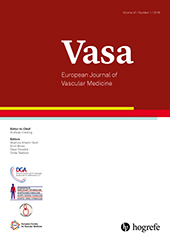Mortality in endovascular and open abdominal aneurysm repair – trends in Germany
Abstract
Abstract.Background: We analysed trends in mortality of endovascular (EVAR) and open aortic repair (OAR) in patients hospitalized for abdominal aortic aneurysms (AAA) in Germany from 2005 to 2015. Patients and methods: We used national statistics published by the Federal Statistical Office in Germany to calculate mortality rate of patients hospitalized with ruptured (rAAA, n = 2,448 in 2005, n = 2,180 in 2015) and non-ruptured (iAAA, n = 11,626 in 2005, n = 14,205 in 2015) AAA. Results: Considering only those who were treated with EVAR or OAR, treatment rates of iAAA with EVAR increased to 78.2 % in males and 72.6 % in females in 2015 and treatment rates of rAAA to 36.9 % and 40.7 %, respectively. In cases with iAAA, death rates associated with EVAR decreased in males from 2.1 to 1.1 % (p = 0.0005) in the period from 2005 to 2015 but not in females (1.8 % in 2005 and 2.3 % in 2015, p = 0.8511). Similar trends are seen in cases with rAAA (males 30.1 % and 24 %, p = 0.1034, females 36.4 to 37.3 %, p = 0.8511). Death rates associated with OAR increased in males from 4.7 % in 2005 to 5.7 % in 2015 (p = 0.0103) and tended to increase in females from 6.8 to 8.2 % (p = 0.1476). In cases of rAAA, there were no changes. EVAR treatment rates increased in cases with iAAA in both genders with age, as well as in males with rAAA, but not in females. OAR associated death rates increased with age in rAAA (from around 30 % in the sixth/seventh decade of life to almost 80 % in cases with patients over the age of 90) and in iAAA (from 1.1 to 20 %). Conclusions: The general increase in EVAR procedures in males and females hospitalized for rAAA and iAAA went along with a decrease in in-hospital mortality in males treated with EVAR for iAAA only and an increasing mortality in males treated with OAR for iAAA.
Literature
Variations in Abdominal Aortic Aneurysm Care: A Report From the International Consortium of Vascular Registries. Circulation. 2016;134:1948–58.
Mortality from ruptured abdominal aortic aneurysms: clinical lessons from a comparison of outcomes in England and the USA. Lancet. 2014;383(9921):963–9.
Assessment of International Outcomes of Intact Abdominal Aortic Aneurysm Repair over 9 Years. Eur J Vasc Endovasc Surg. 2017;54:13–20.
National Institute for Health and Clinical Excellence . Stent-graft placement in abdominal aorticaneurysm. Interventional Procedure Guidance 163. London: NICE; 2006.Should the role of EVAR be re-evaluated in light of the 10 year results of EVAR-1? J Cardiovasc Surg (Torino). 2011;52:179–87.
Trends in mortality and hospital admission rates for abdominal aortic aneurysm in England and Wales, 1979–1999. Br J Surg. 2005;92:968–75.
Endovascular treatment of ruptured abdominal aortic aneurysms in the United States (2001–2006): a significant survival benefit over open repair is independently associated with increased institutional volume. J Vasc Surg. 2009;49:817–26.
Expanding use of emergency endovascular repair for ruptured abdominal aortic aneurysms: disparities in outcomes from a nationwide perspective. J Vasc Surg. 2008;47:1165–70.
Combined spinal and epidural anesthesia for open abdominal aortic aneurysm surgery in vigil patients with severe chronic obstructive pulmonary disease ineligible for endovascular aneurysm repair. Analysis of results and description of the technique. Int Angiol. 2010;29:278–83.
Results of endovascular aortic aneurysm repair with general, regional, and local/monitored anesthesia care in the American College of Surgeons National Surgical Quality Improvement Program database. J Vasc Surg. 2011;29:1097–104.
Endovascular stents for abdominal aortic aneurysms: a systematic review and economic model. Health Technol Assess. 2009;13:1–215.
Medicare Services Advisory Committee . Endoluminal grafting for abdominal aortic aneurysm. Canberra: Medicare Services Advisory Committee; 1999.Suitability for endovascular aneurysm repair in an unselected population. Br J Surg. 2001;88:77–81.
Trends in Patient Safety of Intact Abdominal Aortic Aneurysm Repair: German Registry Data on 36,594 Procedures. Eur J Vasc Endovasc Surg. 2017;53,641–7.
Incidence, treatment and mortality in patients with abdominal aortic aneurysms— an analysis of hospital discharge data from 2005–2014. Dtsch Arztebl Int. 2017;114:391–8.
Changes in abdominal aortic aneurysm rupture and short-term mortality, 1995–2008: a retrospective observational study. Ann Surg. 2012;256:651–8.
Treatment of Abdominal Aortic Aneurysm in Nine Countries 2005–2009: A Vascunet Report. Eur J Vasc Endovasc Surg. 2011;42:598–607.
Time trends in hospital admissions and mortality due to abdominal aortic aneurysms in France, 2002–2013. Int J Cardiol. 2017;234:28–32.
. Nationwide rates of conversion from laparoscopic or vaginal hysterectomy to open abdominal hysterectomy in Germany. Eur J Epidemiol. 2011;26:125–33.
Effect of mammography screening on surgical treatment for breast cancer: a nationwide analysis of hospitalization rates in Germany 2005–2009. Eur J Epidemiol. 2013;28:689–96.
National trends for open and endovascular repair of aneurysms in Korea: 2004–2013. Exp Ther Med. 2016;12:3333–8.
Trends in Abdominal Aortic and Iliac Aneurysm Repairs in Norway from 2001 to 2013. Eur J Vasc Endovasc Surg. 2016;51:194–201.
Epidemiology of aortic aneurysm repair in the United States from 2000 to 2010. J Vasc Surg. 2014 ;59:1512–7.
. Trend-break in Abdominal Aortic Aneurysm Repair with Decreasing Surgical Workload. Eur J Vasc Endovasc Surg. 2017;53:811–9.
Morbidity of endovascular abdominal aortic aneurysm repair is directly related to diameter. J Vasc Surg. 2017;17:30369–5.
Decreasing incidence of ruptured abdominal aortic aneurysm already before start of screening. BMC Cardiovasc Disord. 2016;16:44.
Women derive less benefit from elective endovascular aneurysm repair than men. J Vasc Surg. 2012;55:906–13.
Endovascular treatment for ruptured abdominal aortic aneurysm. Cochrane Database Syst Rev. 2017;5:CD005261.
Epidemiology of ruptured abdominal aortic aneurysms in a well-defined Norwegian population with trends in incidence, intervention rate, and mortality. J Vasc Surg. 2015;61:1168–74.
. Mortality after open aortic aneurysm surgery by Australasian surgeons trained in the endovascular era. ANZ J Surg. 2016;86:544–8.
Elective endo-vascular aneurysm repair in the elderly: trends and outcomes from the Nationwide Inpatient Sample. Ann Vasc Surg. 2014;28:798–807.
Outcomes of endovascular and open surgical repair of ruptured abdominal aortic aneurysms in elderly patients. J Vasc Surg. 2017;16:31780–3.
Registry and health insurance claims data in vascular research and quality improvement. Vasa. 2017;46:11–5.



